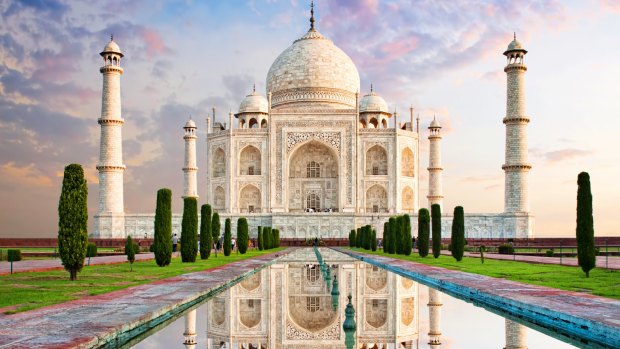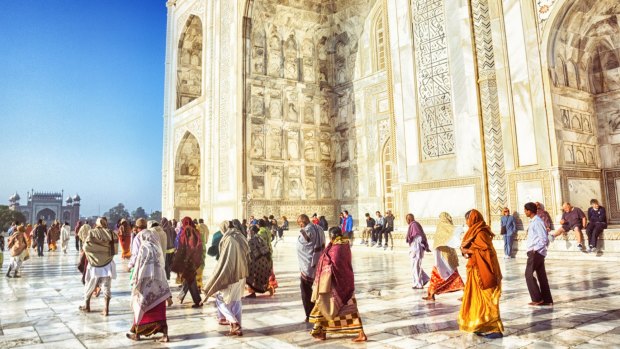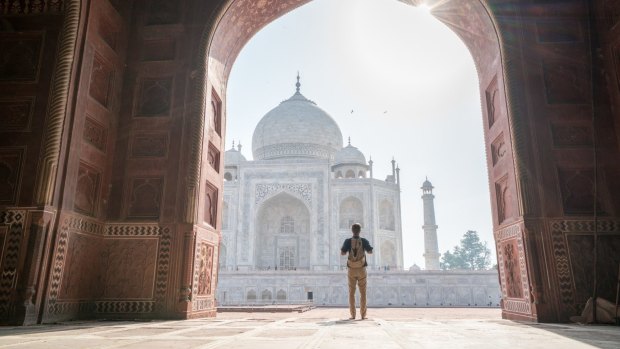This was published 4 years ago
The world's most Googled landmarks: Taj Mahal, Machu Picchu and Burj Khalifa
By Hugh Morris

The Taj Mahal is the world's most-searched landmark, mainly because people don't seem to know where it is. Credit: iStock
Our internet service providers know us better than any of our loved ones.
Into the search bar go our hopes and dreams, insights into our most intimate secrets, and often clues as to the most glaring holes in our knowledge.
How many of your online queries begin "what is…", "where is…" or "who is…"? We'd wager a fair proportion.

The Taj Mahal draws eight million visitors each year. Credit: iStock
New research into the world's most Googled landmarks thus reveals not only which are the most popular, but what about them people are most curious about.
Step forward, the Taj Mahal, recipient of more than 1.41 million monthly searches, placing it at the top of the rankings of celebrated global attractions.
The second most searched is Machu Picchu, with 1.26 million searches, and in third, the Burj Khalifa, 1,1 million. See the full list below, with thanks to insurers Columbus Direct, which pulled the data from Google's Keyword Planner.

To see the Taj Mahal with the smallest crowds, visit early in the morning during winter.Credit: iStock
The world's most-searched landmarks (by number of searches)
- Taj Mahal 1,417,650
- Machu Picchu 1,269,260
- Burj Khalifa 1,103,950
- Niagara Falls 945,810
- Eiffel Tower 916,270
- Stonehenge 833,690
- Mount Everest 778,350
- Statue of Liberty 758,720
- Sagrada Familia 742,470
- Pentagon 732,930
But what do these searches tell us about how Google helps us travel?
Well, at first glance that we are geographically challenged. The top autocomplete results for "the Taj Mahal is…" are "located in…", "in which state…" and "on the banks of…". No one knows where it is.
Similar research is taking place every month around Machu Picchu, with top results "... in what city" (near Cuzco) and "...in which country" (Peru). Those looking for information about the Burj Khalifa are interested in how tall it is (829.8m) and who built it (Adrian Smith of Skidmore, Owings and Merrill).
What do I need to know about the Taj Mahal?
Returning to the Taj Mahal, as it is the most Googled, it is, drum roll, to be found in on the south bank of the Yamuna river in the city of Agra. For those visiting, Agra, in the state of Uttar Pradesh, is part of India's Golden Triangle tourist route that takes in the popular trio of Delhi, Jaipur and Agra, and so, the Taj Mahal features on many an itinerary.
Built in the mid-17th century by the Mughal emperor Shah Jahan as a mausoleum for his favourite wife (of four), Mumtaz Mahal, the Taj Mahal is not, as many of you ask Google, a mosque (though there is one on the 42-acre complex).
It is, as travel expert Gill Charlton says, "the most famous building in the world - and arguably the most beautiful".
"The architecture is sublime but it is the story the stones embody that draws eight million visitors each year," she continues. "It is a monument to the great love between the Mughal emperor Shah Jehan and his queen, Mumtaz Mahal. They could not bear to be parted and Mumtaz would often travel with her husband, even into war. It was on one such campaign in 1631 that she died after giving birth to their 14th child.
"Over the next 14 years Shah Jehan employed the empire's best architects, builders and craftsmen to design this vision in white marble, decorated with precious and semi-precious stones sourced from all over Asia."
The resulting tomb is India's most popular tourist attraction and a building that looms large on the travel wish lists of millions of people worldwide. Unesco, which designated it a World Heritage Site in 1983, describes it as "the jewel of Muslim art in India and one of the universially admired masterpieces of the world's heritage".
What's inside?
The majority of visitors arrive with sharp elbows bent on capturing the best possible selfie with the Taj Mahal in the background, and many leave without experiencing the interior. The mausoleum contains marble cenotaphs to Shah Jehan and Mumtaz Mahal decorated with floral designs using semi-precious stones and surrounded by a carved marble screen.
There is also a pair false sarcophagi on display to the public, and actual tombs at a lower level.
How do I visit?
Overcrowding is the most recent problem facing the Taj Mahal (it has in the past been concerned with aerial bombing in the Second World War and an ongoing pollution-stain crisis).
To deal with the issue, authorities have increased ticket prices for both Indian nationals and foreign visitors. But there is still likely to be tens of thousands of people present every day.
Gill Charlton advises: "To see the Taj Mahal with the fewest people, it is best to arrive at the West or East Gates at 6.30am in winter – around half an hour before it opens (the South Gate doesn't open until 8am). On reaching the East Gate, you will find four lanes leading to security: foreign women, foreign men, local women and local men.
"Joining the queue at 7am can mean a wait of 30 minutes to reach security as a foreigner. If you don't want to get up that early - or it is a really foggy morning - the queue is often shorter around 8.30am after the first rush to get in."
The Telegraph, London
Sign up for the Traveller Deals newsletter
Get exclusive travel deals delivered straight to your inbox. Sign up now.